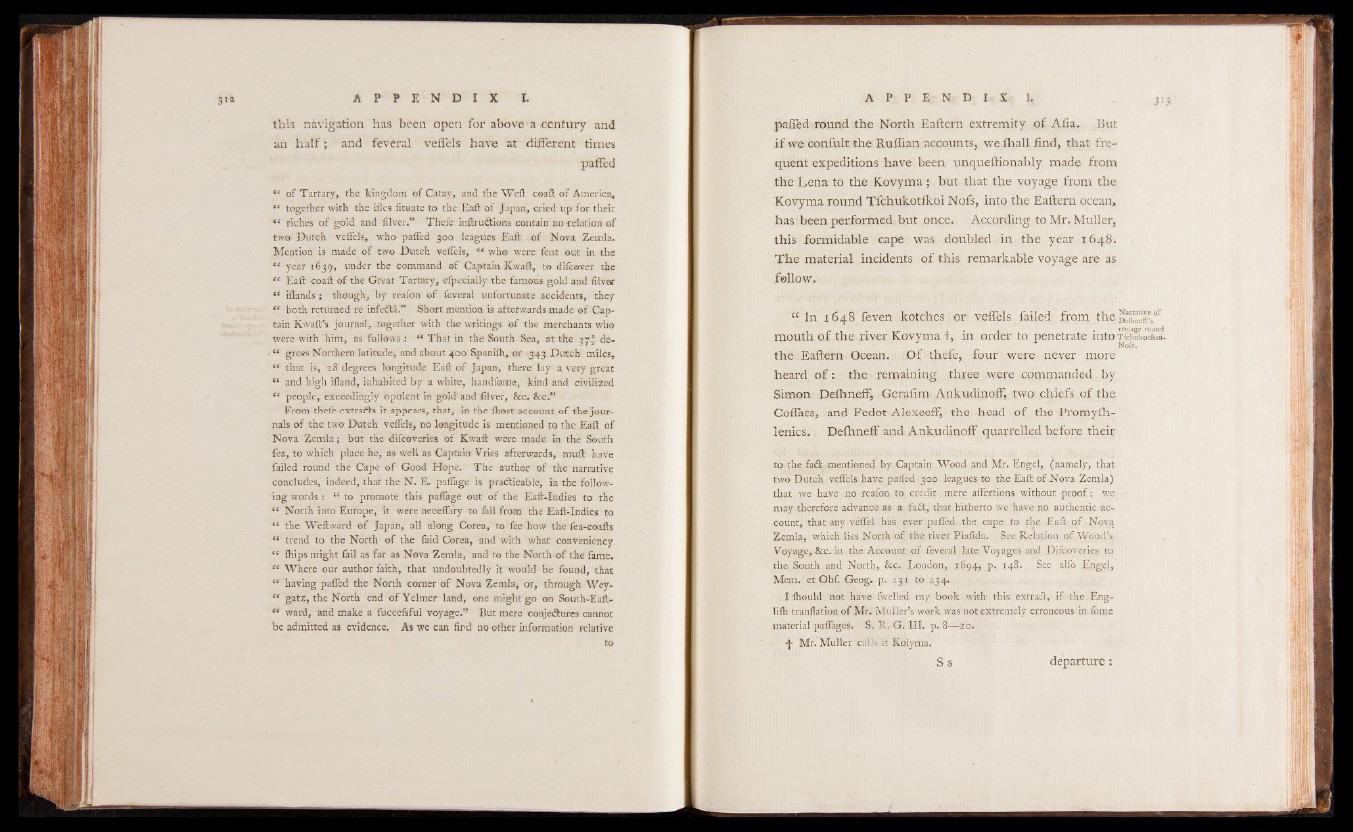
this navigation has been open for above a century and
an half; and feveral veffels have at different times
paffed
“ of Tartary, the kingdom o f Catay, and the Weft coaft o f America,
“ together with the ifles lituate to the Eaft o f Japan, cried up for their
“ riches of gold and filver.” Thefe inftrudtions -contain no relation of
two Dutch veffels, who paffed 300. leagues Eaft o f Nova Zemla-
Mention is made o f two Dutch veffels, “ who were feat out in the
“ year 1639, under the command o f Captain Kwaft, to difcover tjie
“ Eaft coaft o f the Great Tartary, efpecially the famous gold and filver
“ iflands; though, by reafon of feveral unfortunate accidents, they
“ both returned re infedta.'” Short mention is afterwards made o f Captain
Kwaft’s journal, .together with the writings o f the merchants who
were with him, as follows.: ■“ That in the South Sea, at the v y ) de-
1 “ grees Northern latitude, and about 400 Spanilh, or .343. Dutch miles,
“ that is, 28 degrees longitude Eaft o f Japan, there lay a very great
“ and high ifland, inhabited by a white, haudfome, kind and civilized
“ people, exceedingly opulent in .gold' and filver, See. & c.”
From thefe extradts it appears, that, in the fhort account o f the journals
o f the two Dutch veffels, no longitude is mentioned to the Eaft of
Nova Zemla; but the difesveries o f Kwaft were made in the South
fea, to which place he, as well as Captain Vries afterwards, -muft have
failed round the Cape o f Good Hope. The author of the narrative
concludes, indeed, that the N . E. paffage is practicable, in the following
words : “ to promote this paflage out o f the Eaft-Indies to the
“ North into Europe, it were neoeffary to fail from the Eaft-Indies to
“ the Weftward o f Japan, all along Corea, to fee-how the fea-coafts
“ trend to the North o f the faid Corea, and with what conveniency
“ fliips might fail as far as Nova Zemla, and to the North o f the fame.
“ Where our author faith, that undoubtedly it would be found, that
“ having paffed the North corner o f Nova Zemla, or, through Wey-
“ gatz, the North end o f Yelmer land, one might go on South-Eaft-
“ ward, and make a fuccefeful voyage.’* But mere conjectures cannot
be admitted as evidence. As we can find no other information relative
paffed round the North Eaftern extremity of Alia. But
i f we confult the Ruffian accounts, we ffiall find, that frequent
expeditions have been unqueftionably made from
the Lena to the Kovyma ; but that the voyage from the
Kovyma round Tfehukotfkoi Nofs, into the Eaftern ocean,
has been performed but once. According to Mr. Muller,
this formidable cape was, doubled in the year 1648.
The material incidents of this remarkable voyage are as
fellow.
“ In 1648 feven kotches or veffels failed from the M™rsof
. __ . . , . . voyage round
mouth or the river Kovyma t , in order to penetrate into Tfchukodkoi-
Nofs.
the Eaftern Ocean. O f thefe, four were never more
heard o f : the remaining three were commanded by
Simon Defhneff, Gerafim Ankudinoff, two chiefs o f the
Coffees, and Fedot Alexeeff, the head o f the I’romyfh-
lenics. Defhneff and A nkudin off quarrelled before their
to the fadt mentioned by Captain Wood and Mr. Engel, (namely, that
two Dutch veffels have paffed 300 leagues to the Eaft o f Nova Zemla)
that we have no reafon to credit. mère affertions without proof : we •
may therefore advance as a fadt,' that hitherto we have no authentic account,
that any veffel has ever palled the cape to the Eaft o f Nova
Zemla, which lies North o f the river Piafida. See Relation o f Wood’s
Voyage, &c. in the Account of feveral late Voyages and Difcoveries to
the South and North, &c. London, 1694, p. 148. See alfo Engel,
Mem. et Obf. Geog. p. 231 to 234.
I Ihould not have fwelled my book with this extract, if -the Eng-
lilh tranllation o f Mr. Muller’s work was not extremely erroneous in. fome
material paffages. S. R. G . III. p. 8— 20.
■ f Mr. Muller calls it Kolyma. ' ■
Ss departure :